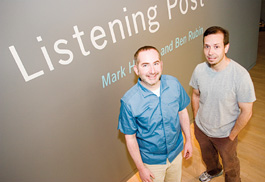home | metro silicon valley index | the arts | visual arts | preview

Data Miners: Ben Rubin (left) and Mark Hansen turn data into art.
Someone's Listening
A new computer installation at the San Jose Museum of Art mines the Internet in real time for found poetry
By Michael S. Gant
THANKS to data-mining, the NSA, cookies, Google, RFID, bar codes and GPS, we are all data points on someone's grid. Opting out is no longer an option. The question now is how many ways can you slice into the new global brain represented by the neural mesh of the Internet?
New York sound artist Ben Rubin was born in 1964 and is thus old enough to remember a relatively unplugged era but not old enough to be a genuine Luddite. He is experimenting with what he calls the "collective buzz" of the world mind in a piece named The Listening Post. First fashioned in 1999-2001 with Bell Labs statistician Mark Hansen, The Listening Post has been mutating and growing ever since.
The multimedia installation comprises 231 tiny vacuum fluorescent display screens. They hang on wires in a gently curving 11-by-21-screen grid suspended from the ceiling in the darkened upstairs gallery of the San Jose Museum of Art.
The glowing screens are connected to computer processors that continuously search computer chat rooms and bulletin boards retrieving messages based on varying search algorithms. Snippets of messages plucked in real time from that sea of ever-churning communications scroll across the screens in complex patterns. Random words and phrases are converted into words by a voice synthesizer and read or sung over a minimalist musical background.
In this flux of glowing type and intonation, the basic units—letters and words—of net traffic are turned into a kind of found poetry depending on how Hansen and Rubin program their algorithms, how they cast their net into the teeming ocean of networked words as millions of souls compose missives, rants and mash notes in public forums. (Rubin stresses that the project only trolls public exchanges, not private, one-on-one email conversations.)
One of the artists' algorithms starts backward, pulling from this vast ready-made lexicon the least-frequent words and flashing them on the screens in order of their rarity. What you see is a proofreader's fever dream—bizarre typos and slip-of-the-fingers, such as "hurigiedty," "borumilemise," zipping by, like sightings of extinct birds in the sky. Eventually real but very odd words pop up, recognizable language growing from chaos.
Another program sorts messages by length. Minute messages accrete words, then rush forward, filling the screens with longer and longer fields of words until the whole array of screens fills up like a field of brilliant light. There is no chance to read any individual message; there is only the sense that communications is a flux, like a force field.
One sequence derives from the observation that the most common phrases in chat rooms are the existential declarations "I am," "I like" and "I love." Sweeping through all the messages, the digital harvester gathers a litany of such basic human statements from the banal—"I LOVE THA BEACH"—to the lustful— "I LIKE UR TITS."
A full sequence of algorithms takes about 20 minutes and The Listening Post can be enjoyed from a padded bench as if it were a short movie, letting the waves of light and sound wash over you as a form of full immersion in a sensory overload tank. Or you can walk up close to the screens and attempt to read the individual messages as they zip past, as if picking out a single silvery fish in a whole school of darting sardines.
The experience is at once transcendental, a visualization of the collective consciousness. And it is voyeuristic, a form of eavesdropping that takes on an added edge of sinister implications in the wake of the NSA's own data mining program.
The Listening Post is one of two large installations (along with Ingo Gunther's WorldProcessor) in "Edge Conditions Part I," an exhibit leading up to the cutting-edge digital-art ZeroOne festival in August. Part II introduces the work of a dozen addition experimental artists, starting July 29.
Edge Conditions Part I shows through Nov. 26, Part II shows July 29-Nov. 26, at the San Jose Museum of Art, 110 S. First St., San Jose. (408.271.6840)
Send a letter to the editor about this story.
|
|
|
|
|
|